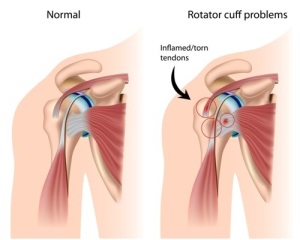This outline is about rotator cuff tendinitis. First, the rotator cuff is a round sheath of tendon tissue, which is located in the space below the acromion. In addition, there are a group of muscles from the shoulder girdle that all insert into it.
For one thing, this way the body can decide which way to move the arm or shoulder. It is important to realize that the set-up is similar to a “puppet on a string” where the rotator cuff and the tendons of the surrounding muscles move parts of the shoulder and the arm. In this case the muscles that participate by way of insertion into the rotator cuff are the supraspinatus, the infraspinatus, the subscapularis and the teres minor (see this link). To clarify, the biceps tendon from the long head does not participate in the rotator cuff, but goes right underneath the rotator cuff. In like manner, the short head of the biceps inserts at the front of the shoulder blade (at the coracoid process).
Shoulder impingement
Second, with repetitive movements of the arm, particularly with forward movement above the horizontal, there is a danger that some tendons rub underneath the acromion or get squished between the acromion and the humeral bone, called “shoulder impingement“. Apart from the rotator cuff there is also a bursa, called the subacromial bursa. Impingement can irritate the subacromial bursa. This is what physicians call “shoulder bursitis” (or subacromial bursitis).
Rotator cuff tendinitis
Third, the tendons of the two muscles that are particularly in danger of being irritated like this are the biceps muscle tendon and the supraspinatus muscle tendon. As they insert into the rotator cuff or are in very close proximity to the rotator cuff (in the case of the biceps tendon from the long head) , repetitive motion can cause a rotator cuff tendinitis in the front (biceps tendinitis) or on the side (supraspinatus tendinitis). Often these names are almost used synonymously : rotator cuff tendinitis, biceps tendinitis and supraspinatus tendinitis, although technically the biceps tendon is separate from the rotator cuff as mentioned.
Treatment
Dr. Taunton, Professor at the University of BC, Vancouver, and Sports Medicine Director of the Allan McGavin Sports Medicine Centre in Vancouver, talked about the use of topical non-steroidal anti-inflammatories in tendinitis cases (Ref.7). He recommended Pennsaid, a commercially available preparation can be applied to the skin and penetrates considerably deep to reach the inflamed tendons. This preparation is a mixture of the anti-inflammatory Diclofenac (1.5%) and the vehicle DMSO, which also has anti-inflammatory properties. Compounded medicine that the pharmacist mixes with Lecithin, 5 to 10% Diclofenac and use this as cream or a patch (under a saran wrap) is also available. Also, avoid loading the tendons. This means that the work or sports activities have to be modified until the inflammation has completely settled. Not doing so would risk the development of a rotator cuff tear (see link below under “Related Page”).
References
1. ABC of rheumatology, second edition, edited by Michael L. Snaith , M.D., BMJ Books, 1999.
2. The Merck Manual, 7th edition, by M. H. Beers et al., Whitehouse Station, N.J., 1999.
3. Goldman: Cecil Textbook of Medicine, 21st ed.(©2000)W.B.Saunders
4. Ferri: Ferri’s Clinical Advisor: Instant Diagnosis and Treatment, 2004 ed., Copyright © 2004 Mosby, Inc.
5. Rakel: Conn’s Current Therapy 2004, 56th ed., Copyright © 2004 Elsevier
6. Wheeless’ Textbook of Orthopaedics: http://www.wheelessonline.com/ Several topics can be found under this link by entering the term you search for.
7. The 50th Annual St. Paul’s Hospital Continuing Medical Education Conference for Primary Physicians, Nov. 16 – 19, 2004
8. Suzanne Somers: “Breakthrough” Eight Steps to Wellness– Life-altering Secrets from Today’s Cutting-edge Doctors”, Crown Publishers, 2008







